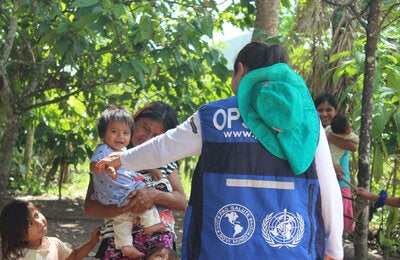
Washington, D.C., November 26 2018 (PAHO/WHO) – While progress in the Region of the Americas has been made over the past 20 years to harmonize national regulatory systems in order to ensure access to safe, effective and quality medicines, more must be done for well-functioning health systems that want to achieve Universal Health.
This was one of the primary outcomes of the IX Conference of the Pan American Network for Drug Harmonization (CPANDRH), held in San Salvador, El Salvador, last October. The theme of the Conference was “Commemorating 20 years of PANDRH and 40 years of Alma-Ata: The contributions of regulatory harmonization on achieving Health for All.”
“Alma-Ata noted that access to essential medicines is one of the necessary components to achieve the goal of Health for All, said Jarbas Barbosa, Assistant Director at the Pan American Health Organization (PAHO). “Essential medicines are critical to addressing public health priorities. And many of the most important public health achievements of our continent have been reached, in part, thanks to access to these essential products.”
This sentiment was echoed by Leonor de Acosta, Director of El Salvador’s National Medication Authority. “History has demonstrated that countries can work together, under the leadership of PAHO, to address major health problems and ensure access to safe, effective and quality medicines in the Americas," she said. Some of this progress, highlighted during the Conference, includes improved capacity building of regulatory authorities, and the creation of institutional development plans to address priority challenges.
PAHO and PANDRH called on countries of the Region to continue to work on ensuring the development of national regulatory systems to guarantee access to safe, effective and quality medicines.
Over the past 20 years, regulatory authorities have improved in their capacities through a PAHO-led assessment based on a standardized and transparent process. Eight regulatory systems in the Americas have been designated National Regulatory Authorities of Regional Reference (NRAr) as they are deemed by PAHO to fulfill a high percentage of regulatory capacity indicators. Together, these NRAr systems ensure that 82% of the population has access to quality medicines and health. Countries with legal and organizational frameworks for a comprehensive system cover another 16% of the population. About 2% of the population in the Americas -around 18 million people, live
within systems that have little to no frameworks for medicine regulation, a situation that leaves this group vulnerable to substandard quality, ineffective or falsified medication.
“While the Region as a whole has advanced in terms of its capacity to regulate medicines and in the development of regulatory systems, we still face many challenges,” said Analía Porrás, Chief of the Medicines and Health Technology Unit at PAHO. “We need to continue promoting good regulatory practices and the exchange of experiences and regulatory knowledge between NRAs in the Americas.”
During the Conference, participants also called on international health and development authorities, as well as the pharmaceutical industry, to help strengthen regulatory systems in those countries and markets with limited resources. Furthermore, given recent advances in the availability of cutting-edge therapies, particularly involving cells and tissues, participants called for more stringent regulation.
Regulatory harmonization in the Americas
Harmonization of the regulation of medicines and other health technologies ensures that, in an increasingly globalized sector, safe and effective medicines are available from country to country and region to region. This is important both for innovator and for generic versions because it accelerates access to medicines and other state-of-the-art health technologies, and improves working alliances across countries. Generics enable countries to consume quality medicines at accessible prices which positively impact the sustainability of national health systems. Ultimately, harmonization leads to strengthened regulatory systems.
The Pan American Network for Drug Regulatory Harmonization (PANDRH) is an initiative created by PAHO and national regulatory authorities in the Region of the Americas in 1999 to ensure that all national-level regulatory systems are fit for purpose and appropriate for their national context.
The main objectives of PANDRH are to strengthen regulatory functions of the countries of the Americas; develop proposals for the convergence of regulatory standards according to international guidelines; provide capacity building to support good regulatory practices among Member States; and to encourage national regional authorities to develop and maintain well-structured organizations.
“PANDRH has been vital to ensuring collaborative approaches for regulatory systems and the exchange of best practices between national regulatory authorities strengthening for the last 20 years,” said Porrás. “This is key to safeguarding access to effective, quality medicines and other health technologies in the region.”



